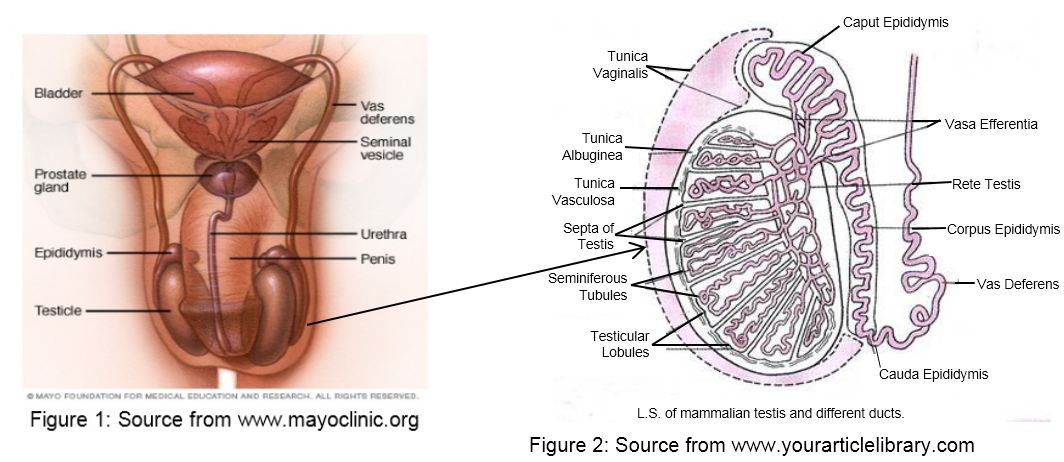Introduction
The purpose of the organs of the male reproductive system is to perform the following functions:
- To produce, maintain, and transport sperm (the male reproductive cells) and protective fluid (semen)
- To discharge sperm within the female reproductive tract during sex
- To produce and secrete male sex hormones responsible for maintaining the male reproductive system
Organ Involve
The organs involve in male reproductive system is located outside of the body and these external structures include the penis, scrotum, and testicles with the testes being the male primary sex organ.

| Penis | : | Erected part during sexual intercourse to deliver semen into the vagina |
| Scrotum | : | This is the loose pouch-like sac of skin that hangs behind and below the penis. It contains the testicles. The temperature of the scrotum is at least one degree celsius lower than the body temperature. |
| Testicles | : | These are oval organs that lie in the scrotum. The testes are responsible for making testosterone (sex hormone) and for generating sperm |
The internal organs of the male reproductive system, also called accessory organs, include the following:
| Epididymis | : | The epididymis is a long, coiled tube that rests on the backside of each testicle. It transports and stores sperm cells until maturity. |
| Vas deferens | : | The vas deferens is a long, muscular tube that travels from the epididymis into the pelvic cavity. The vas deferens transports mature sperm to the urethra. |
| Ejaculatory ducts | : | These are formed by the fusion of the vas deferens and the seminal vesicles. The ejaculatory ducts empty into the urethra. |
| Urethra | : | A tubular structure that transports semen and urine. |
The male reproductive system also equipped with reproductive glands which produce secretions that become part of semen. These glands include:
| Prostate gland | : | Located below the urinary bladder in front of the rectum and contributes additional fluid to the ejaculate. The fluid helps to nourish the sperm |
| Bulbourethral glands | : | Located below the prostate gland and produces a clear, slippery fluid that empties directly into the urethra and serves to lubricate the urethra and to neutralize any acidity that may be present due to residual drops of urine. |
| Seminal Vesicles | : | Located posteriorly to the urinary bladder and produces some of the liquid portion of semen that contribute more than 70% of the total ejaculate which is slightly alkaline. |
Sperm Pathway during Ejaculation
Summarize below is the sperm pathway during ejaculation starting from spermatogenesis in the seminiferous tubule.
Spermatogenesis (in seminiferous tubule) ? epididymis ? vas deferens ? ejaculatory duct ? urethra ? Sperm is pushed out of the male body during ejaculation
Conclusion
These organs work together to produce sperm (the male gamete) and the other components of semen. They work as a system to deliver semen out of the body and into the vagina where possible fertilization with oocytes would occur to produce offspring.
References
- Alcamo, E., & Bergdahl, J. (2003). Anatomy Coloring Workbook. Coloring Workbooks Series. Princeton Review. New York. Pg. 260-262. ISBN 0375763422.
- Basu, S. C. (2011). Male Reproductive Dysfunction. Jaypee Brothers Publishers. Jaypee Brothers Publishers. New Delhi. Pg. 15-19. ISBN 9350252201, 9789350252208
- Clark, R. K. (2005). Anatomy and Physiology: Understanding Human Body. Jones & Bartlett Learning. United States of America. Pg. 171-173. ISBN 0763748161, 9780763748166
- Reis, A. B. & Oliveira, M. M. R. (2014). Surgery, Vas deferens anastomosis and epididimovasostomy male fertility surgical treatment simulation model using human and bovine placenta. Fertility & Sterility. 169.
| Last Reviewed | : | 04 January 2016 |
| Writer | : | Tajul Ariffin Isa |
| Accreditor | : | Krishnan a/l Kanniah |







